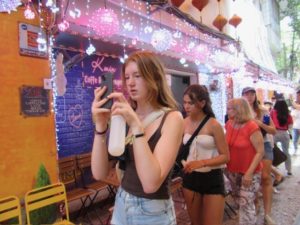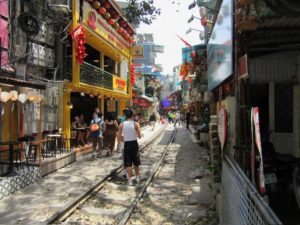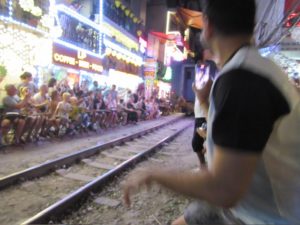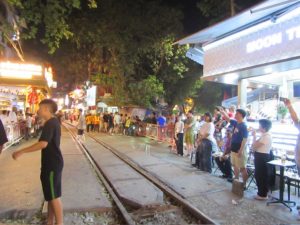 When I first heard of Hanoi’s ‘Train Street’, I thought to myself, “What’s so great about seeing an ordinary train?”. After all, train travel is pretty common in India and in Vietnam too. I had planned on taking the iconic ‘Reunification Express’ that spans a distance of approximately 1,700 kilometers connecting Hanoi in the north to Ho Chi Minh City in the south. Intrigued, I made my way there on a humid Tuesday afternoon, winding through umpteen two-wheelers and street food vendors that define Hanoi’s texture. Using navigation applications on my phone, I found vague guidance, but it was the sound of a distant horn and the sudden shift in crowd behaviour that told me I was close.
When I first heard of Hanoi’s ‘Train Street’, I thought to myself, “What’s so great about seeing an ordinary train?”. After all, train travel is pretty common in India and in Vietnam too. I had planned on taking the iconic ‘Reunification Express’ that spans a distance of approximately 1,700 kilometers connecting Hanoi in the north to Ho Chi Minh City in the south. Intrigued, I made my way there on a humid Tuesday afternoon, winding through umpteen two-wheelers and street food vendors that define Hanoi’s texture. Using navigation applications on my phone, I found vague guidance, but it was the sound of a distant horn and the sudden shift in crowd behaviour that told me I was close.
 Tucked away in a tangled alleyway in Hanoi’s Old Quarter, I found the ‘Train Street’, one of the city’s most extraordinary and pulse-quickening attractions, a narrow residential lane where a fully operational train rumbles through, inches from front doors, plastic stools, and drying laundry, where chaos meets charm in true cinematic fashion.
Tucked away in a tangled alleyway in Hanoi’s Old Quarter, I found the ‘Train Street’, one of the city’s most extraordinary and pulse-quickening attractions, a narrow residential lane where a fully operational train rumbles through, inches from front doors, plastic stools, and drying laundry, where chaos meets charm in true cinematic fashion.
The entrance was tucked next to a railway crossing gate, behind a small cafe, past a bill board warning of restricted access and the dangers of being too close to a railway track. Rightly so, because safety was usually given a go-by by tourists often found loitering in the path of an oncoming train merrily clicking selfies, behaving as if they were in an amusement park forgetting this was real, gritty,  functioning rail infrastructure cutting through a residential neighborhood. Stools and tables were placed all along the track, and very soon I was accosted by a vagabond who insisted I buy something at the cafe or leave. Choosing to stay, I was seated soon enough, a few inches from the steel rails and handed a can of Coca Cola. “You have to time the arrival of a train right,” I remembered being told, “or you might miss the whole thing.” I needn’t have worried, my vagrant had become my local guardian, “Five minutes more,” he said with a grin.
functioning rail infrastructure cutting through a residential neighborhood. Stools and tables were placed all along the track, and very soon I was accosted by a vagabond who insisted I buy something at the cafe or leave. Choosing to stay, I was seated soon enough, a few inches from the steel rails and handed a can of Coca Cola. “You have to time the arrival of a train right,” I remembered being told, “or you might miss the whole thing.” I needn’t have worried, my vagrant had become my local guardian, “Five minutes more,” he said with a grin.
The lane was so narrow that I could stretch out my arms and almost touch both sides. Balconies hung overhead, lines of colorful laundry danced in the breeze, and children darted through with practiced nonchalance. It wasn’t long before the gentle murmur of conversation was interrupted by a distant, rhythmic rumble.
 An electric charge rented the air as hundreds of tourists leaned closer to the walls, shopkeepers pulled in stools, and photographers adjusted their lenses. The ground began to tremble slightly, my vagrant told me to get back, farther away from the tracks. And then, with a blare of its horn, the train appeared, a beast of metal and motion, squeezing through the alley with machine-like precision.
An electric charge rented the air as hundreds of tourists leaned closer to the walls, shopkeepers pulled in stools, and photographers adjusted their lenses. The ground began to tremble slightly, my vagrant told me to get back, farther away from the tracks. And then, with a blare of its horn, the train appeared, a beast of metal and motion, squeezing through the alley with machine-like precision.
It was both terrifying and exhilarating. The train passed so close I could hear metal clanging against metal, the world turning into a rush of sound and vibration, my pulse elevated and my senses wide awake. And just like that, it was gone,the lane fell back into its quiet hum, as if nothing had happened. Everyone began to leave.
 Why did this magical experience of ‘Train Street’ leave me thrilled? Obviously not the train itself, but the juxtaposition of daily life inches away from mechanical danger, by the manner in which residents adapted to trains passing inches away from them. They don’t just live next to the tracks, they thrive beside them, letting tourists like me gawk in wonder, momentarily invited into this delicate dance of danger followed by normalcy.
Why did this magical experience of ‘Train Street’ leave me thrilled? Obviously not the train itself, but the juxtaposition of daily life inches away from mechanical danger, by the manner in which residents adapted to trains passing inches away from them. They don’t just live next to the tracks, they thrive beside them, letting tourists like me gawk in wonder, momentarily invited into this delicate dance of danger followed by normalcy.
Shillong too, should soon have a railway line to boost connectivity, tourism and economic growth, to ease travel, link remote areas and reduce dependence on road transport. And when Shillong gets its own ‘Train Street’, the rhythm of the city will surely beat strongest between the rails!
(The author is a regular contributor at The Shillong Times)



